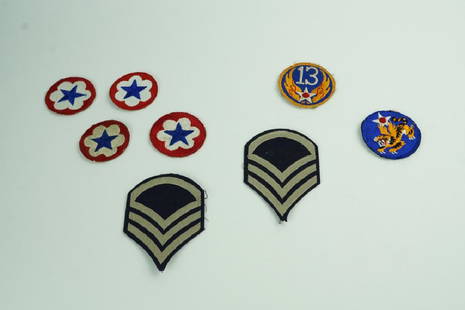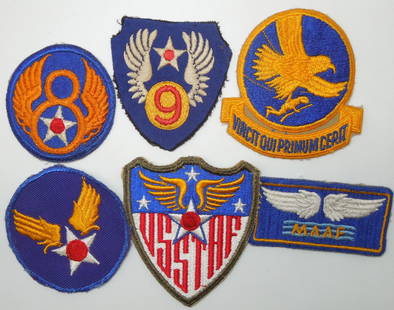
WWII US AIR CORPS 668TH BOMBER SQUADRON PATCH WW2
Similar Sale History
View More Items in Militaria & War MemorabiliaRelated Militaria & War Memorabilia
More Items in Militaria & War Memorabilia
View MoreRecommended Collectibles
View More



Item Details
Description
WWII Squadron Patch with accompanying letter that reads: DONALD H. DENNINGER 29 CENTRAL WOODS LN. BROOKHAVEN, N.Y. 11719 To Whom It May Concern. The 59 Hand Painted Patches that accompany this letter were obtained by me from John Holt, who obtained them from Frank Fitzgerald. They are Hand Painted at the Walt Disney Studios in California before and during World War Two and were used as the models for the leather patches that the United States Army Air Force wore on their leather flight jackets during world war two. These patches were originally obtained by a construction crew who were hired by the Walt Disney Studios to do some remodeling work after Walt Disney died. These patches were to be destroyed but instead were kept by the construction foreman and later sold to Mr. Frank Fitzgerald who in turn sold them to Mr. Ron Fischer of Washington D.C., and Mr. John Holt of Long Island, N.Y... In December of 1996 I purchased the patches that Mr. Holt had but was unable to contact Mr. Fischer to see if he wanted to sell his patches to me.I had the patches researched at a local University Art Dept. And was told that the patches were the work of the Walt Disney Studios, and that they were painted during the World War Two era, 1939-1941. This patch has been removed from an album but in excellent condition. History: World War II: The squadron was first activated at Will Rogers Field, Oklahoma as the 668th Bombardment Squadron, one of the four original squadrons of the 416th Bombardment Group. Although designated as a light bomber unit, in June 1943 it moved to Lake Charles Army Air Field, Louisiana, where it was an Operational Training Unit for North American B-25 Mitchell medium bomber units. In September, the squadron equipped with Douglas A-20 Havoc light bombers and began to train with them for deployment the European Theater of Operations. The squadron departed the United States at the beginning of January 1944. The squadron arrived at RAF Wethersfield, England, its first European station, in February 1944. Although its parent 416th Group was the first A-20 unit to be assigned to Ninth Air Force, its aircraft were transported by ship and lagged behind the ground and air echelons of the squadron. However, It was able to fly its first combat mission, a diversionary mission for heavy bombers flying in Operation Pointblank on 3 March. Initially most of its missions were flown against V-1 flying bomb and V-2 rocket launch sites in France. It flew a number of missions against airfields and coastal defenses to help prepare for Operation Overlord, the invasion of Normandy. The unit supported the invasion in June 1944 by striking road junctions, marshalling yards, bridges, and railway overpasses. The 668th assisted ground forces at Caen and supported Operation Cobra, the breakout at St Lo in July. Later in the summer it supported operations near Brest by hitting transportation facilities, supply dumps and radar installations. In spite of intense resistance, the squadron bombed bridges, (including one of the last bridges across the Seine at Oissel) railways, rolling stock and a radar station to disrupt the enemy's retreat through the Falaise Gap between 6 and 9 August, for which it was awarded a Distinguished Unit Citation. In September, the squadron provided support for Operation Market Garden, the airborne attack attempting to establish a bridgehead over the Rhine in the Netherlands. Later that month, it moved to Melun Airfield, France to reduce response times for ground support of the advancing Allied forces. It supported the assault on the Siegfried Line by with attacks on transportation, warehouses, supply dumps and defended villages in Germany. At Melun, the squadron became part of the first group in IX Bomber Command to convert to the Douglas A-26 Invader. It was taken off operations on 6 November, and flew its first mission with the new plane on 17 November, attacking a depot at Haguenau. Because all Invaders delivered to the unit were solid nosed versions, it retained a few A-20s to lead boxes in formation bombing. It would not be until a mission on 8 February 1945 that the squadron would have sufficient glass nosed A-26s on hand to retire its A-20s from combat. During the Battle of the Bulge the following month, it used its new bomber to attack transportation facilities, strong points, communications centers and troop concentrations. This support lasted until January 1945. The squadron also aided the Allied advance into Germany by continuing its strikes against transportation, communications, airfields and storage depots. It bombed flak positions in support of Operation Varsity, the airborne assault across the Rhine, in March 1945 and continued operations until 3 May, when it flew its last mission of the war. The unit remained in Europe after V-E Day until September 1945, when it returned to the United States for inactivation at the port of embarkation on 11 October 1945.
Buyer's Premium
- 20%
WWII US AIR CORPS 668TH BOMBER SQUADRON PATCH WW2
Estimate $300 - $500
9 bidders are watching this item.
Shipping & Pickup Options
Item located in Willoughby, OH, usOffers In-House Shipping
Local Pickup Available
Payment

Related Searches
TOP





























































![[CHINESE PROPAGANDA]. Group of 10 posters. Circa 1940s. Gro...: [CHINESE PROPAGANDA]. Group of 10 posters. Circa 1940s. Group of World War II era Chinese propaganda posters, including: Our Armies Will Bend But Not Break; The War Above All/Victory Above All (portra](https://p1.liveauctioneers.com/928/325952/175495312_1_x.jpg?height=310&quality=70&version=1712935174)




















